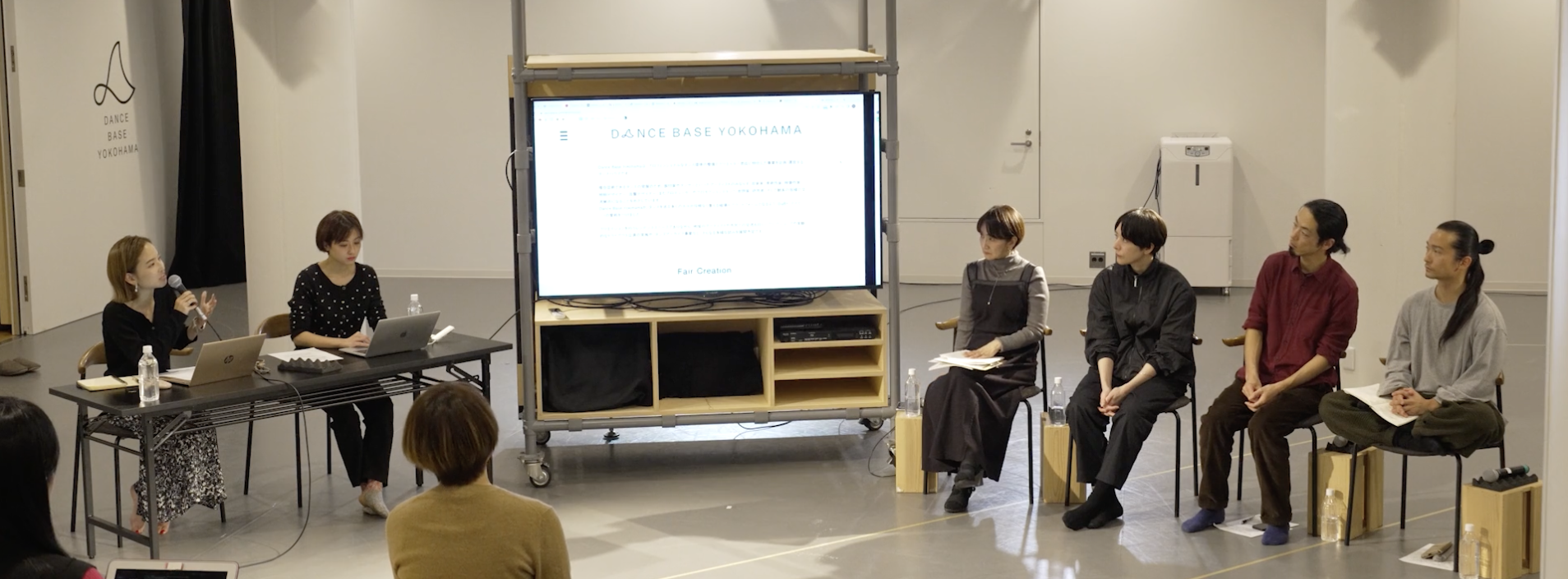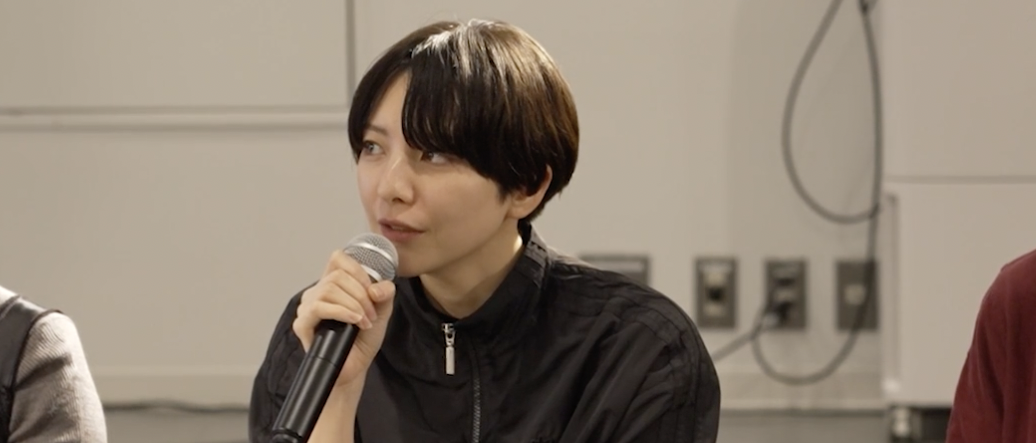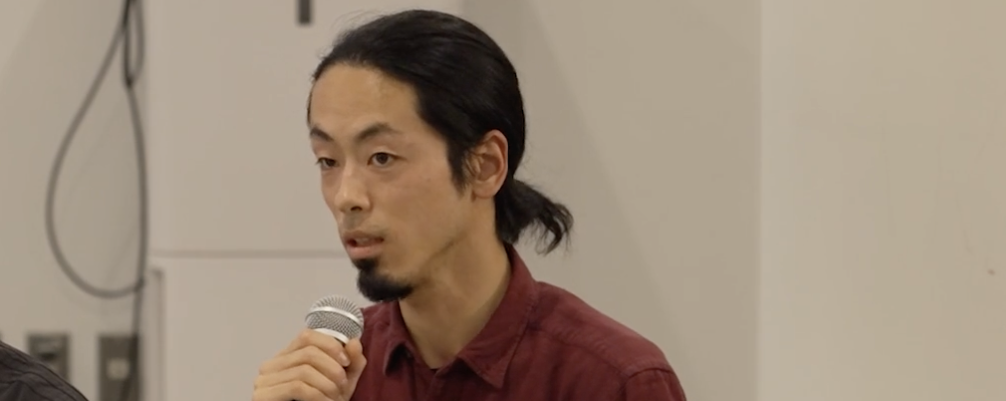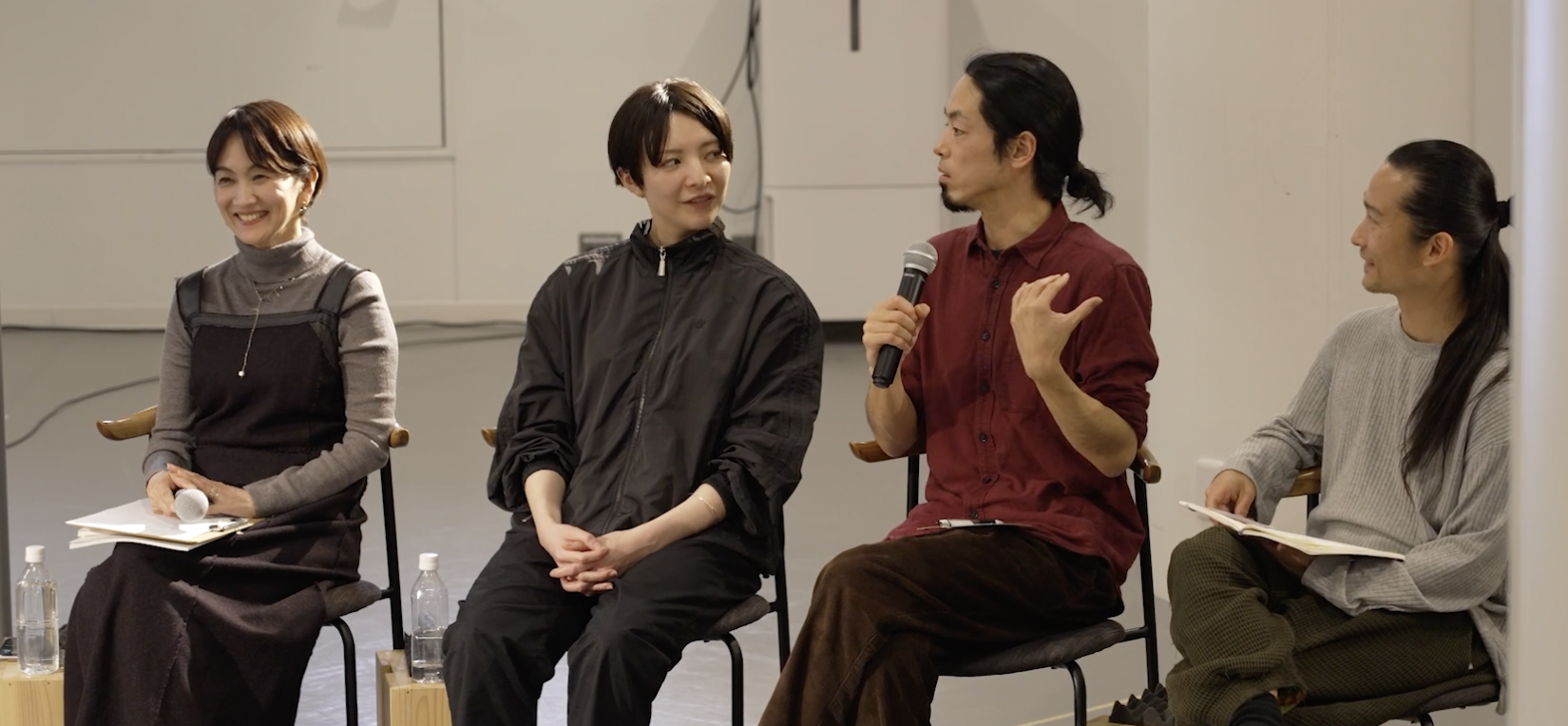OpenLab DaBY Round Table Talk vol.1 Saori Harasaori x Yohei Hamada x Takuya Fujisawa x Eri Karatsu Case Study: Overseas Creative Environment (2)

OpenLab DaBY Round Table Talk Case Study: Overseas Creative Environments vol. 2.
■Vol. 1 is here:
■Full video is here
Speakers: Saori Hara, Yohei Hamada, Takuya Fujisawa, Eri Karatsu
Facilitators: Chihiro Tokai, Yuka Kamimura
Ease of continuing artist activities and challenges at each location
Tokai: Thank you very much. Now, could you tell us a little more subjectively what you think is good about the environment and social system of dance houses in which you have lived, and what you think is easy to dance in this environment? What do you think is good about the environment and social system of dance houses?
On the other hand, there may be some difficulties because of the minority status of Japanese people, or simply because of the minority status of dance in the country.

Hala: As I mentioned earlier in terms of the direction of dance houses, Berlin was very broad in terms of what constitutes dance. I originally studied visual design and have a background that shifted toward performance and dance after my undergraduate and MA. In Japan, after all, if you suddenly want to become a dancer at the age of 23, are you going to go to a physical education college now? It was like that. There were not many opportunities for me to think of dance as an expression of what I wanted to do, which was to place the medium of the body in time and space. Even if I had wanted to do something like this or liked an artist like that, I never thought it would be categorized as dance, so I felt like I had no idea what to do.
Ultimately, the reason I chose Germany in the first place was that while I was studying design, there were artists in the Bauhaus design movement who were expressing themselves in a rather physical way. I thought that if it were to deal with the body from the perspective of design, it would be possible to create something like a dance even now. Before going to Berlin, I actually did a residency at the Bauhaus University. I had taken a grant there to begin with and was accepted. Although it has changed as an institution with the existing Bauhaus University in Weimar and the Bauhaus that was there in the 1900s, it had a lot of materials and I was able to study the Bauhaus-like essence and formative aspects of the Bauhaus.
That is when I began to show up at dance houses in Berlin, feeling that in order to be at the forefront of dance and contemporary dance, I had to go to Berlin, not to the countryside. I was shocked by a performance I saw there, a 60-minute piece by a freelance dance artist at a theater called Sophienzeile, which was called a “dance,” and I felt that “this could be dance. When I looked at her profile, I saw that she had graduated from the Berlin University of the Arts with a degree in Solo Dance Performance, and I decided at random that this was where I would definitely end up, but I don’t think this would have happened in Japan. Anyway, the visuals were sophisticated, and the fact that the choregraphy was about transforming time in ways other than physical dynamism was a great relief to me. I felt that what I was thinking about was nothing new, that it was already there, and in a way, I had a vision of training at the age of 22. Dance is, in a sense, a limited proposition in Japan, but I think the beauty of Germany is that there is a degree of tolerance, or a fluffy outer edge, which was a good opportunity for me to be freed from anxiety. In fact, there were many artists whose backgrounds were visual, or who became actresses after working as doctors, and who were classmates in the same solo dance performance department as I was. So it is natural that there are twists and turns.

One of the difficulties was that we had to use our background as a weapon. Contextualization, or contextualization, is a process that took a lot of cost and time. In order to get a grant, I am forced to explain everything I have done, what I have been doing, why I have to do this now at this time, and the rationale for my being on stage. I’m glad I did that training, but I’m exhausted by the fact that contextualization determines the game when it comes time to continue my activities. As the resolution of what I want to do increases, there are still things that cannot be contextualized. Contextualization is for the context in German society, and I have to keep looking at myself as content for German society. And as a result, I gradually lose more and more of my own process. So I took a break, and I feel like I’m in a phase where I’m somewhat dropping out of German society. Four or five years have passed since I graduated. It has been 10 or 11 years since I saw a piece and was so shocked that I decided to become a dancer. I felt like it was time to move on. The last year or two of my stay was quite painful. To be honest, I was at the mercy of how much this contextualization was something that I put a lot of emphasis on.
Tokai: I was wondering if it is connected to the fact that you are required to text, but I was also wondering if it is quite systematic that you cannot cross the state.
Hala: It is. As long as the cultural system is rigidly set up, there is some inflexibility. Because of that, there is no way to do things when you don’t get a grant, and there are times when you feel like this year is already over, that this term is over.
Karatsu: But on the other hand, as long as you live there, does it mean that nationality and other factors are irrelevant?
Hala: That is really true. I don’t know what is actually going on, but on the surface it is absolutely not allowed anymore, as if Germans are being given preferential treatment. On the contrary, and I digress a bit, but in Berlin there is a pretty direct connection between so-called politicking and performance. There are clearly certain topics that are more likely to be accepted for funding each year. Now, the topic of research is connected to the background with the politically complex situation in Israel and Palestine, or a while ago it was about immigration and Syria, or relations with Russia. A little bit before that was Black Lives Matter, and before that was the Me too movement, feminist art. Roughly every year or two, the acceptance rate changes in a pretty obvious way. Gender Performance is also strong because it is a central topic in Berlin. So, if you are not a gender minority, you are not immigrant, you are not of conflict origin, you are not of black descent, and if you are Asian, you have to put in some Asian background that they expect you to have, and so on.
In terms of not being able to cross state lines, of course you are free to do things within a state, but in Berlin, for example, there is a very strong sense of political identity. Anyone can do it, but instead, there is a direct connection between the identity and the work. And there is a trend that it is good to have variety in the dance industry. If you are in the middle of it, you may think, “Really? I sometimes wonder. There are certainly opportunities.
Karatsu: We have an open call for artists in residence at DaBY, but DaBY is open to people from any country, and we don’t ask where they live or their birthplace at all. How about Berlin in that area? Do you give preference to those who are resident?
Hala: Yes, that’s right. First of all, the grant may come from the country (federal) or from the state. With public subsidies that come from the state, you must be able to prove residency, and if from the state, you must have a German visa. Also for example,
Tanzfabrik
(Tanzfabrik)
for example, does not require proof of nationality or place of residence. All you need to do is to collect your own grant and cover your travel and accommodation expenses. However, for the so-called “Agency for Cultural Affairs” or “Arts Council Tokyo” in Japan, proof of residency is required.
Tokai: How about you two?
Hamada: There are a lot of queers in Norway right now. I have always been interested in the body; I started dancing when I was over 20 years old, and while I didn’t have a ballet or dancer’s body, I wanted to make the most of the body I already had. After thinking about what I could do with it, I became interested in the kind of body that is neither individual nor universal, nurtured by culture rather than something that everyone has. When I was in Japan, I was thinking about the Japanese body and the Western body, and I kept going in circles until I went to Norway. I went to Norway with my mind still in a complete limbo, thinking about the Japanese body and the Western body, and I couldn’t understand it because the context was completely different. I spent about five years trying to re-contextualize it so that it would be understood in the other country’s context, and I presented a piece in August 2023, at which point I finally realized that I didn’t need to deepen the contextualization and that it was time to talk about the kind of body I wanted to pursue. I finally realized that it was time for me to talk about what kind of body I wanted to pursue.

What I like about Norway is that, above all, it starts with the idea that you can be paid for your creations. It leads to the story that follows,
Norske Dansekunstnere
(There was a union called “Norske Dansekunstnere” (Norske Dansekunstnere).
It is a more relaxed organization than Norske Dansekunstnere, but they have guidelines that say you should receive this amount per year depending on your years of experience, and you should receive this amount per diem. They give subsidies based on these guidelines.
Karatsu:By the way, how much per day is your base?
Hamada: I multiply the base daily rate plus the social security tax I pay by 36.8%. I have been doing this for eight years now as a professional, so a total of 3,300 kronor for one day. In Japanese yen, that’s about 45,000 yen. For performance, it is usually set at about 5,000 kronor per day regardless of the number of times, so from 60,000 to just under 70,000 yen.
Karatsu: Prices are also high. When I visited Norway about seven years ago, I was surprised that a Big Mac from McDonald’s cost about 3,000 yen. I can’t simply compare the two.
Fujisawa: It is quite expensive compared to Sweden. Both prices and subsidies. Norway produces oil, so the country is rich, but the cost of basic living is quite high, and salaries are about twice as much as in Sweden. There is also that kind of difference in prices.
Hamada: So what happens is that Norwegian dancers don’t work outside the country. Especially in Bergen, where I lived, there were quite a few artists who came from other European countries, but they inevitably feel closed off. The system is too firmly established, and if you work in another country, you can’t pay your rent or mortgage. On the other hand, in Norway, banks consider scholarships from the government as a stable income, so people buy houses while they are still students, and it is common for artists to buy a house before they are 30 years old, and the idea is that they would rather buy a house than pay rent.
Karatsu: I think it is a good thing if the guarantees are stable and if the work is very good, but it is also possible for the quality of the work to decline if the goal is only to receive money. I think there are stories of dancers who, when they became salaried dancers, would have preferred to make their own work even if they had to pay for it themselves. How about Norwegian dancers?
Hamada: Come to think of it, that was my first shock. I thought I had seen many more interesting works when I was in Japan. I don’t know what it was, but there was a lot of energy swirling around. But when I went to Norway and was thinking about going inside, I was desperate for food. Even when I got a big grant, I was thinking that I was working three times as hard as the people who were getting the same budget. I thought, “People aren’t working. There is something to be said for being too protected.

Fujisawa:The basic way of thinking of Scandinavian people is that work and private life have the same priority. So, from the perspective of Japanese people’s values, it may seem lazy, but it is normal for dancers to have families and children in Scandinavia. One cultural difference is that artists are established as a profession, so they demand private time as a matter of course.
Hamada: That is exactly why I was puzzled, but I came to appreciate the system. When I started this project and was in the position of hiring, one of the dancers in the creation process became pregnant and gave birth, and at the August premiere, I had my one and a half year old child with me the whole time, I was under a lot of pressure and had to think a lot about what I was going to do. For example, in Norway, working hours are generally from 8:00 or 8:30 to 16:00, but dancers usually work from 10:00 to 16 or 17:00. I warm up, and then after a little while, I take a lunch break, and when I want to continue, it’s already approaching 5:00 p.m., and it’s like I have to finish when the engine starts to rev up. I experienced it as a dilemma that I had my baby with me and could not extend the time any further.
Fujisawa: I also have to finish work at 4:00 p.m. Because I have to drop off and pick up my children, the whole society is already closing at 4:00 p.m. In Sweden, it is not 4:00 p.m., but I was with the Company for a long time, and there was a law that people with children could leave at 4:00 p.m.
Hamada: What time is dinner in Sweden? In Norway it is 5:00 p.m. We have a custom of eating dinner at 5:00 p.m., so according to that, we have to finish at 4:00 p.m. Instead, we have a four-meal-a-day culture where we eat our evening meal around 10:00 p.m. and go to bed.
Fujisawa:Dinner is around 6:00 to 7:00 pm. In the Gothenburg company, we used to start at 10:00 and end at 18:00, but then the children started talking. We decided to try a 9:30 start and 5:30 end, and now we are talking about an 8:00 start and 5:00 end. There is a lot of movement to create conditions where everyone can work the same way. The country is very strict about fairness.
I also started dancing late, at the age of 23, but when I started dancing, I felt that Japan was very concerned about age, and there was a tendency to say that one should not start dancing after the age of 23, which I think is not quite right. After I started dancing and came to Tokyo, I worked part-time at a dance studio, where many teachers came from overseas. I was told. To start or not to start is what matters, not age. Of course, whether you can become a professional or not depends on your effort.
They are also very tolerant when it comes to changing jobs. In Scandinavia, university tuition may be free or inexpensive, but there is a tremendous amount of support for changing careers. I think this is something that should be incorporated in Japan, not only for artists, but also for other fields.
Also, on the subject of politics, the films that were selected were, last year, the story of a lesbian in her 50s who was a refugee from Iran and a local queer person. Not that that is good or bad. I had a chance to talk with a person in charge of selecting works for the Agency for Cultural Affairs, who is also a choreographer, and he said, “I’d really like to select a work about flowers,” and I thought it was difficult for them to do so. I feel that there is too much of a bias toward politics. Of course, refugees and LGBTQ people are important issues, but I think that the essence of art, which is not bound by politics, fads, or trends, has been reduced in Sweden as well.

With regard to grants, how do artists get work? Company artists are, of course, guaranteed a salary, and all pensions and insurance are covered, but freelance artists don’t have that, so it came up on the Swedish government’s agenda in 1996 to find out what to do about it. People in any job have the right to unemployment insurance, to take vacations, and to have a family, but there was no legislation in place for freelance artists. That came up on the agenda, and first of all, the heads of actors affiliated with theaters and the heads of actors in the freelance labor union set up a meeting and submitted a draft to the government. As a result, a federation was formed. The federation is a system to support freelancers, and when they are out of work, the trade union makes a rough estimate of their salary and pays it to the freelancers. Not all of them, of course, but those who are registered with the labor union are guaranteed. This was not money that just sprang up, but a budget was raised to provide guarantees to freelancers that had not been done within the original unemployment insurance framework.
Then, in 2006 Dansalliansen (Dansalliansen) The organization started with 3 dancers, but now there are 70 dancers and they receive a monthly stipend. It is renewable for two years, and you have to be active as a dancer for eight months every two years, either by initiating a project or participating in other people’s projects. The program is renewed for two years. Dance Ariansen and Dance Centrum (Danscentrum) Dance Alyansen and Danscentrum are linked together and provide daily training to freelance dancers free of charge, as well as a salary. They invite artists from Japan and abroad for workshops, and they also have a workshop called “Choreographer Meeting” where they invite various choreographers and create opportunities for dancers and choreographers to meet. I think this could be done in Japan as well. As for the 3,000 empty boxes I mentioned earlier that have fallen all over Japan, the reason why no one uses them is that they are expensive to use. Especially in the suburbs, there are some nice boxes standing, but no one can use them. It may take time to negotiate with the government for such places, but if the box is used effectively, it will be a positive addition to the financial resources. I think how to utilize the places that are already there is something to think about.
Tokai: I am a lawyer, so I was quite surprised that a support system for freelancers had been thought of since 1996. Japan has just now passed a law for freelancers, and it will be a long time before it is adapted to the characteristics of the industry. I don’t think that this is an immediate delay, but I did think that the environment was very different to begin with.
Fujisawa:Yes. It was mentioned that artists do not know where to begin to call themselves professionals, and it is necessary to change the mindset of artists who have difficulty in confidently saying, “This is my work. I think it would be good if both sides could change their mindset that this is a proper job.
Continue to OpenLab DaBY Round Table Talk Case Study: Overseas Creative Environments (3)


